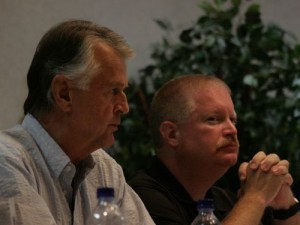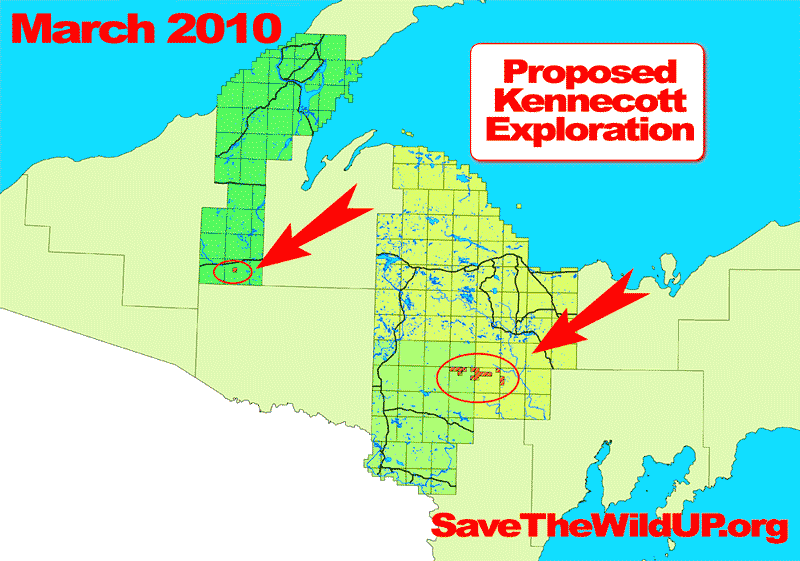Enbridge CEO: “We are fully committed to returning this river back to the way it was before, if not better,” says Daniel.
By Todd A. Heywood 8/12/10 11:17 AM of Michigan Messenger
MARSHALL — In a 30-minute interview with the Michigan Messenger, Enbridge CEO Patrick Daniel pledged to return Talmadge Creek and the Kalamazoo River to the way it was prior to the oil spill, but he downplayed any long-term damage from the leak while experts say the effects on both wildlife and human life could be significant and long-lasting.
Over the weekend, local newspapers have reported on the potential long-term effects on the local ecosystems and on the fact that the oil spill has silenced the songs of frogs, which are so key to the web of life on the river. Experts say this is not uncommon with releases of toxic substances into waterways. Frogs, they say, are exceptionally sensitive to the chemicals. But Daniel seemed unconcerned about any long-term dangers.
“I don’t think it is [accurate that the ecology of the river will suffer long term], at least no significant ecological damage,” Daniel, 63, said. “The experts are going to be more believable on this than I, but any experience I have had with any spills that we have had in the past … is that there are few long term impacts.”
In the Detroit Free Press, experts said the rupture of Enbridge’s Lakehead Pipeline 6B in late July has likely decimated smaller animals in the ecosystem. Those smaller animals — frogs, smaller fish, insects — are the bottom to the ecological food chain. They are also most likely to have been negatively impacted by the more than one million gallons of Cold Lake Crude oil that flowed down Talmadge Creek and into the Kalamazoo River, impacting in all about 30 miles of waterway in Calhoun County.
Asked if the reports of the silenced chorus of amphibians concerned him, he responded, “It concerns if that is the case. I also, though, would expect a full recovery from that and fairly quickly.”
But in other cases of major spills, that has not been the case. While the Exxon Valdez spill was much larger than this one, 21 years later the smaller fish that provide food for larger ones and were the basis of the local fishing industry have still not returned to the areas affected by the spill. In reality, the long-term effects from that spill have actually exceeded the predictions of scientists at the time.
And the long-term effects on human health could be severe, though difficult to quantify and pinpoint. Benzene is a known carcinogen, and the tar sands oil that spilled into Michigan waterways is known to contain much higher levels of heavy metals than regular crude oil.
It was on that issue — the type of oil being transported in the pipeline when it ruptured — that Daniel finally reconciled his own previous statements with what experts have said.
“No, I haven’t said it’s not tar sand oil. What I indicated is that it was not what we have traditionally referred to as tar sands oil,” Daniel said when asked about the Messenger’s report identifying it as such. “If it is part of the same geological formation, then I bow to that expert opinion. I’m not saying ‘No, it’s not oil sands crude.’” It’s just not traditionally defined as that and viewed as that.”
Enbridge has said the oil that was flowing through 6B at the time of the rupture was Cold Lake Crude, which must be mixed with a lighter petroleum product called diluent in order to thin it out enough to push through the line. Experts tell Michigan Messenger this mix can lead to various issues with the pipelines, including false readings and alarms from the remote sensing computer system used to control the network of pipelines.
“No, there really shouldn’t be any correlation between the type of crude and the impact on the pipelines,” Daniel said. He said the mixing of the crudes to thin them out makes that issue a non-issue.
What is more important, however, is the issue of corrosion on the line, Daniel said. But experts told the Messenger that the use of diluent does not increase corrosion in the pipes. Still, how the company handles corrosion is an important piece of the puzzle.
Under federal regulations pipelines are regularly inspected by a tool called an “intelligent pig.” The tool is a high tech version of an elongated rubber ball that is used to clean the lines called a “dumb pig.” The intelligent pigs carry ultrasound equipment and “an onboard computer,” Daniel said.
As they go through the lines they record the readings of the ultrasounds on the lines, and that data is then analyzed “much like x-rays or an MRI,” Daniel said.
“[Analysts] say ‘OK, here’s the signature of a potential problem,’” said Daniel. “Then we go in and either reduce the pressure and if it looks like it is threatening the safety of the line based on PHMSA [Pipelines Hazardous Material Safety Administration] standards we proceed with the dig and sleeve program. Or both.”
Anomalies in Lakehead Pipeline 6B were found that way earlier this year and Enbridge, as late as July 15, was negotiating with regulators at PHMSA about what a response to those readings should be. Daniel said that at the time of the Marshall incident, there was a “dig program” underway further up the line. In such situations, the company either places an additional thickness of steel around the line to reinforce it, or if the detected “anomaly” is large enough, they cut out the pipe and replace it.
The line in Marshall had no such anomaly detections, Daniel said.
As for the Line 5, which snakes across the state’s upper peninsula, across the straits of Mackinac down the East side of the state and across the St. Clair River to Sarnia, Ontario, Daniel said the line was functionally stable.
“Not that I am aware of,” Daniel said when asked if there were any anomalies detected on Line 5. He also said the spur from 6B to Toledo, Ohio had no issues either. The Michigan Messenger has filed Freedom of Information Act requests with the PHMSA seeking inspection reports for all of the pipelines in the state of Michigan, but has not yet received that material.
Daniel took pains to explain that every piece of metal has anomalies.
“There are anomalies in all pipelines — and in fact in all metal,” he said. The pigs help the company identify those issues, he said, and then the company proceeds to fix those which were identified as likely problems.
With multiple investigations happening as a result of the spill, as well as the release of information from various sources, Daniel was asked if this pipeline spill had been too politicized.
“I haven’t really thought of it as political, in that we all want to rest assured that when we start this line back up, that it’s done safely,” he said. “I have to admit I have focused more on the facts and issues around it than I have on the sequencing of the word coming out. I’m really not that worried about it.”
But sometimes, such as when rumors swirled around that an Enbridge employee had been on the site of the leak on July 25, the night before it was discovered, Daniel admits he is frustrated. The NTSB investigation prevents him from discussing the specific information, such as the location of his company employees and trucks.
Even as some claim Enbridge’s public proclamations of wanting to do right are a public relations ploy, Daniel says he has moved to Michigan for the foreseeable future to continue to meet with residents and leaders and oversee the clean up and remediation of the river.
“We are fully committed to returning this river back to the way it was before, if not better,” says Daniel.
Congressional Hearings scheduled http://www.lansingstatejournal.com/article/20100806/NEWS01/8060319/-1/RSS?obref=obinsite

 Recently the DNRE announced a public comment period for leasing over 4000 acres of mineral rights to Kennecott for further exploration. The exploration would take place in Southern Marquette County, Northern Dickinson County, and Southern Houghton County.
Recently the DNRE announced a public comment period for leasing over 4000 acres of mineral rights to Kennecott for further exploration. The exploration would take place in Southern Marquette County, Northern Dickinson County, and Southern Houghton County.
